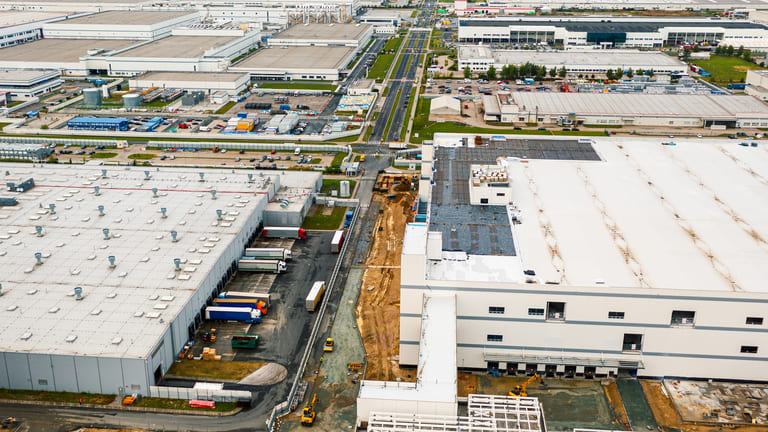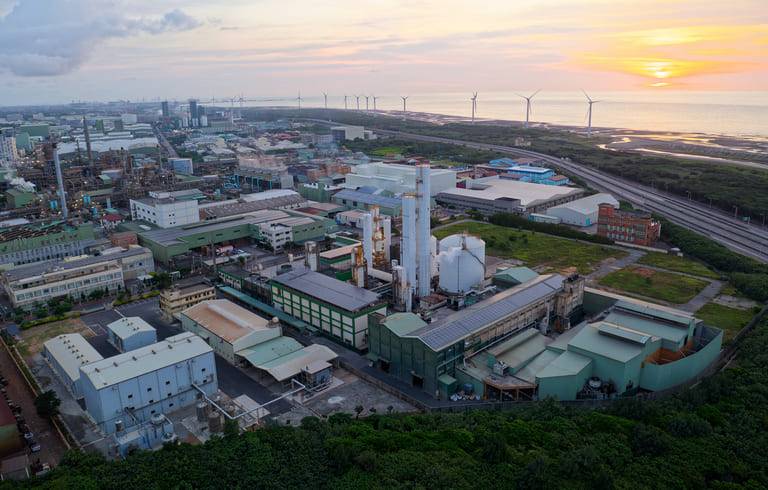

Taiyo Kogyo Column
Attention to zoning for warehouse construction|Explanation of the different standards and selection process for commercial warehouses and private warehouses.
2025.05.02

When building a warehouse, it is essential to check the “zoning”.
Zoning is a classification by the Ministry of Land, Infrastructure, Transport and Tourism that defines the intended use of land.
This determines whether a warehouse can be built and the restrictions that apply.
Understanding the detailed selection process is necessary, especially since there are different criteria for commercial and private warehouses.
This article details the criteria and selection process for each.
>> Click here to visit our website specializing in “Tent Warehouses”.
What is a zoning district?

A zoning district is an area where the Ministry of Land, Infrastructure, Transport and Tourism has defined the purpose of land use based on urban planning.
Especially in urbanized areas, designation is mandatory and encourages planned land use.
This regulates the type and size of buildings that can be built in each area.
Zoning is divided into three main categories: “industrial,” “commercial,” and “residential,” and is further divided into 13 zoning districts.
Residential areas include “Type 1 exclusive district for low-rise residential buildings,” while commercial areas include “neighborhood commercial districts.
Industrial areas are designated as “semi-industrial zones” and other suitable uses are defined for each area.
This system prevents uncontrolled development and maintains an appropriate balance between residential and business activities.
It is essential for companies and individuals to identify zoning when utilizing land.
Industrial zoning
Industrial zoning is an area primarily for building factories and warehouses.
It is designed to limit the mix of residential and commercial buildings and to facilitate industrial activity.
| Area Name | Regulation | Buildings that can be built |
| Semi-industrial area | Residences and small factories can coexist | Residences, factories, stores, warehouses |
| Industrial area | Residential construction is possible, but mainly for factories | Factories, warehouses, stores, some housing |
| Industrial Zone | Limited to industrial uses, residential and schools are prohibited | Factories, warehouses |
Commercial zoning
Commercial zoning is an area primarily intended for the construction of stores, offices, and commercial facilities.
These are classified into two types: “neighborhood commercial districts” and “commercial districts,” each of which has different restrictions on what buildings can be built and what is regulated.
Neighborhood commercial districts are often designated along “shopping streets” and “arterial roads” such as prefectural and national highways, and require construction that takes the living environment into consideration.
On the other hand, commercial areas are often designated around “large cities” and “terminal stations,” where larger-scale commercial facilities can be built.
| Area Name | Regulation | Buildings that can be built |
| Neighborhood Commercial District | Allow commercial activities for the convenience of neighborhood residents | Stores, offices, karaoke boxes |
| Commercial Areas | More commercial oriented than neighborhood commercial areas | Office buildings, movie theaters, department stores |
Residential zoning
Residential zoning districts are lands that have been systematically designated to form primarily people’s living spaces.
The types of buildings that can be built depend on the regulations of each area. They are classified into the following eight categories, ranging from areas with strict regulations to areas with relatively loose regulations, with a focus on residential buildings.
| Area Name | Regulation | Buildings that can be built |
| Type 1 exclusive district for low-rise residential buildings | Strict height restrictions, mainly for low-rise residences | Detached houses, small apartments, elementary schools, etc. |
| Type 2 exclusive district for low-rise residential buildings | In addition to Type 1 exclusive district for low-rise residential buildings, small stores are allowed | Detached houses, small apartments, stores (below a certain size), etc. |
| Type 1 exclusive district for medium and high-rise residential buildings | Area for mid- and high-rise residential buildings, hospitals and universities are possible | Apartments, condominiums, hospitals, universities, etc. |
| Category 2 exclusive district for medium and high-rise residential buildings | Less restrictions on stores and offices than in Type 1 exclusive district for medium and high-rise residential buildings | Condominiums, hospitals, universities, stores of a certain size, etc. |
| Type 1 residential district | Primarily residential, but also allows for small-scale commercial facilities | Apartments, stores, schools, hospitals, etc. |
| Second-Class Residence District | Commercial facilities are allowed even more than in Type 1 Residential District | Condominiums, commercial facilities, hotels, offices, etc. |
| Semi-residential district | Coexistence of residences and commercial facilities along arterial roads, etc. | Residences, shopping centers, factories of a certain scale, etc. |
| Rural Residential District | Areas where agriculture and housing can coexist | Residences, direct sales of agricultural products, farmhouse restaurants, etc. |
Zoning districts where warehouses can be built

Zoning is divided into three types of 13 categories, each with different facilities that can be built.
Warehouses are also subject to zoning regulations, which limit where they can be built.
There are two types of warehouses: “commercial warehouses” for business purposes and “private warehouses” for personal use, and the areas in which they can be built differ depending on the zoning.
In other words, the suitable areas for warehouses for business use and warehouses for personal use differ.
Therefore, when constructing a new warehouse, it is necessary to confirm the appropriate zoning for the intended use.
Zoning districts where commercial warehouses can be built
There are six zoning districts in which commercial warehouses can be built.
These are semi-residential areas, neighborhood commercial areas, commercial areas, semi-industrial areas, industrial areas, and exclusive industrial areas.
Strict restrictions are imposed in residential areas, and business warehouses can only be built in semi-residential areas.
On the other hand, in commercial and industrial areas, there are no restrictions based on zoning, and building is permitted.
Because sales warehouses involve large-scale facilities and people coming and going, they have a significant impact on the living environment, and regulations are being tightened in residential areas.
Zoning districts where private warehouses can be built
There are 10 zoning districts in which warehouses can be built.
Seven of these areas, namely Type 2 Residential District, Semi-Residential District, Neighborhood Commercial District, Commercial District, Semi-Industrial District, Industrial District, and Industrial District, allow construction without restrictions on zoning.
On the other hand, in Type II exclusive district for medium and high-rise residential buildings, construction is permitted on the condition that the building has no more than two floors and no more than 1,500 m2 , and in Type I residential district, no more than 3,000 m2 .
In rural residential areas, construction is allowed only for the purpose of storing agricultural products and materials.
Industrial zoning is recommended for warehouses.

When using a warehouse, it is recommended to choose a facility in an industrial zoning district.
In industrial areas, there are fewer regulations regarding the number and size of building floors and stored materials, allowing for more flexible operations.
These areas are particularly suitable for storing large quantities of hazardous materials.
Many of the industrial areas are also close to highways and arterial roads, making them convenient for logistics.
Easy access to transportation can also improve delivery efficiency and reduce costs.
In addition, the warehouse is more flexible in terms of space allocation and stored items, making it easier to accommodate business growth.
However, depending on the characteristics of the products handled, it may be necessary to combine operations with commercial or residential areas.
Flexible selection of areas for different uses is important.
Be aware of building restrictions based on building-to-land ratio and floor-area ratio

Even in areas where buildings can be constructed, there is no limit to the number of buildings that can be built.
Each area has a building-to-land ratio and floor-area ratio, and building restrictions are imposed based on these ratios.
The building-to-land ratio is the ratio of building area to site area, and the floor-area ratio is the ratio of total floor area.
What is Floor Area Ratio?
Building-to-land ratio and floor-area ratio are important standards that limit the size of buildings that can be constructed on a lot.
The building-to-land ratio is the ratio of building area to site area.
The floor-area ratio, on the other hand, refers to the ratio of the total floor area to the site area.
The total floor area is the sum of the floor areas of all floors in the building.
The floor-area ratio is calculated by the formula “total floor area ÷ site area × 100.
For example, if a 70m2 floor is built on a 100m2 lot with two floors, the floor area ratio would be “(70+70)/100 = 140%”.
All floors are included in the calculation, but some structures such as entrances, balconies and lofts are not included in the total floor area.
Basements and garages may also be excluded from the floor area ratio.
This system is called “Special Exception for Relaxation of Floor Area Ratio” and allows the maximum floor area ratio to be relaxed according to urban planning.
This system allows for effective use of land even when the site is small.
These restrictions and special exceptions must be fully considered when developing architectural plans, and appropriate designs must be made.
Mitigation Measures in Disaster Prevention Stockpile Warehouses
Disaster prevention stockpile warehouses are facilities that store emergency food and rescue supplies in preparation for disasters.
To make it easy for users to recognize it, it should be clearly marked “Disaster Prevention Warehouse” in a location that is visible from the outside.
If this warehouse is to be built, a portion of the floor area ratio is exempted.
Specifically, 1/50 of the total floor area can be excluded in the calculation.
In addition, if the building is installed for disaster prevention purposes, a floor-area ratio exemption is applicable up to 1/100 of the total floor area.
This will allow for more effective space design and enhanced disaster prevention measures.
What is Building Coverage Ratio?
The building-to-land ratio is the ratio of building area to site area.
The building area is the area of a building as seen from above, and is calculated based on the size of the first floor, regardless of the number of floors.
For example, if a building of 50m2 per floor is built on a 100m2 lot, the Building Coverage would be 50%.
If a 75m2 building is built on the same size lot, the Building Coverage would be 75%.
This limitation is established to ensure disaster prevention and ventilation.
The upper limit of the building-to-land ratio is set by the Building Standards Law and differs for each area.
These differences are related to “zoning,” and different building-to-land ratios are set for each of the 13 zoning districts.
By setting building standards appropriate to each area, safety and comfort are maintained.
For more detailed information on the Building Standard Law, please refer to the article “What is the Building Standard Law applicable to warehouses? From necessary requirements to restrictions on building-to-land ratio and floor-area ratio,” please refer to the article “What is the Building Standard Law applicable to warehouses?
Zoning Selection Process

When building a factory or warehouse, the first thing to check is the zoning of the subject site.
To find out the zoning, use the city planning maps and online tools provided by the local government.
Many local governments make this information available at their offices or on their official websites. In the case of the Tokyo Metropolitan Government, you can use the “Internet Service for Urban Planning Information”.
You can also use websites that compile city planning maps for the entire country or the “National Urban Planning GIS Viewer” of the Ministry of Land, Infrastructure, Transport and Tourism.
However, the most reliable information is the official data of the local government, so it is important to always check the latest information.
Next, it is necessary to find out the regulations for each zoning district.
The main regulations include standards regarding the uses for which buildings can be constructed and the size of structures.
For example, there are building-to-land ratio, floor-area ratio, height restrictions, etc. If these are not taken into consideration, the plan may be significantly altered.
Interpreting these regulations requires specialized knowledge, so consulting with a specialist is recommended. An accurate understanding of the zoning of the land and an appropriate understanding of the applicable regulations will ensure a smooth construction process.
summary
When constructing a warehouse, it is essential to first identify the zoning.
Use zones are defined based on city planning, and the facilities that can be built in each zone differ.
In particular, the standards applicable to commercial warehouses and private warehouses are different and should be thoroughly investigated in advance.
While sales warehouses are allowed to be built in commercial and industrial areas, attention must be paid to the strict restrictions in residential areas.
Private warehouses, on the other hand, can be built in relatively many zoning districts, but there are restrictions based on size and use.
It must also be taken into consideration that even in areas where building is allowed, building size and design may be restricted by regulations such as building-to-land ratio and floor-area ratio.
Proper understanding of these restrictions and planning according to local regulations will allow for more efficient and legal warehouse construction.
It is important to carefully confirm the zoning by using municipal city planning maps and online tools and, if necessary, obtaining expert advice.
For those who have already confirmed the zoning and are actually planning to build a warehouse, the choice of construction method is also important.
Depending on the type and use of the warehouse, it may be worth considering not only the common reinforced concrete or steel construction, but also the option of a “tent warehouse.
Tent warehouses are constructed by assembling a steel frame and covering it with a sheet membrane, and can be constructed at low cost and in a short construction period.
They are durable and weather-resistant, and are so bright during the day that lighting is unnecessary, improving work efficiency.
A large number of advanced manufacturers and companies in the logistics industry have introduced tent warehouses. Consider tent warehouses as a means of achieving efficient warehouse operations.
If you are interested in the Tent Warehouse, please contact Taiyo Kogyo Corporation, a manufacturer that has been in business for 100 years and has the largest market share in Japan.
Tent Warehouseへの
Contact us

What you need to know when building a warehouse
We've packed it all in.
Clues to solving the 2024 problem
<
・Don't know where to start in building a warehouse
・Want to build a warehouse economically
・Want to know which type of warehouse to build
・Anyway, want to learn the basics of warehouse construction
・Worried about the 2024 problem, but don't know what to do
Related Articles
- TOP>
- Taiyo Kogyo Column>
- Attention to zoning for warehouse construction|Explanation of the different standards and selection process for commercial warehouses and private warehouses.








